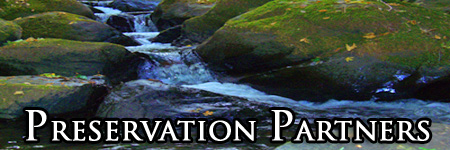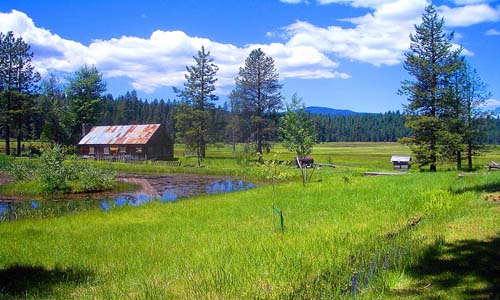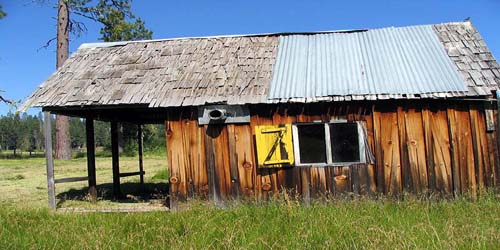
KEEFER VALLEY RANCH
CHESTER, CALIFORNIA
An Italian-Swiss homestead in Sierra Nevada range near Lake Almanor, few have seen the Ranch, largely because it is one of the few High Sierra mountain meadows without a public road running through it. The Keefer Ranch is the first ranch we purchased and was long our most cherished. Dad took time off and brought us to the Ranch to spend our summers when we were growing up. It was a “working ranch” without electricity or phones and it was here that our passion for being “stewards of the land” as our grandfather, Dr. Merritt Horning, tough us, was born. We learned to be watchful for the land’s chief enemies: free ranging cattle (which we drove off the property almost daily) and smoke in the distance, in summertime usually an indication of a lightning fire.
Our summers at the Ranch taught us how devastating cattle grazing could be to the land. The Ranch is forest land and a meadow system that formed near an extinct volcano. The meadows are fed by springs and a creek that winds around the old volcanic cone, a combination of factors which helped produce nutrient rich soils over millennia. This process of soil building enriched the land until the practice of “open range,” as it’s called in the industry, cattle grazing began. Open range meant that it was landowners’ responsibility to keep cattle off their lands rather than the cattle owner’s responsibility to keep them on his or hers. Each cattle rancher was allotted so many cattle based on the grazing capacity of his or her land and these herds were legally allowed to range openly.
On the Ranch, cattle from nearby property wandered into the meadows daily eating grasses and other vegetation right down to the ground. The tall grass is all gone and the surviving vegetation, scarcely more than roots, dried out quickly in the summer sun. The cattle need a lot of water and in the fall, when water becomes scarce, they hang out along the streams destroying the natural grass and root systems which held the soil in place. When high water hits, usually in the spring, the stream banks are torn out by water under pressure, leaving the banks vertical. This condition is extremely difficult to repair for two reasons:
In 1985, prior to the current law, we received permission to rebuild the stream banks so that they sloped upward from the creek, eliminating the vertical banks and ongoing undercutting. The work took all summer with a D-6 Caterpillar. When finished, the banks were reseeded. Unfortunately the ensuing winter had a 100-year warm spring storm that melted snow and caused most of the restored banks to be torn out again. Then the regulations were changed prohibiting the use of equipment to restore stream banks. While some of the restored banks remain, most were washed away, further tearing out the buildup of the pristine meadowlands, an unintended consequence to a wonderful historical lifestyle of raising cattle, something our family did until we realized the unintended damage from cattle in certain conditions. We now devote our holdings which were previously grazed to restoration efforts and wildlife.
Restoration efforts are difficult and expensive. Over the years we’ve planted about five thousand trees around the meadow areas of which roughly 200 have survive. Aspens are coming back with the cattle gone. Aspen trees spread through their root systems and young saplings were eaten by the cattle for many years. Most of the aspens there when the cattle left were very old trees. Young ones are now rebounding.
Fire is the other big peril we watch for and work to prevent. Fire ignited by lightning can take hours to build up enough heat to be a serious threat. Rapid response is everything in forest fires. Since there is no protection against fires in the mountains, we use quad ATVs for rapid mobility and backpack water extinguishers to attack fires before they become uncontrollable. We have also worked for many years with the local logging company which owns most of the area timber to have the forest thinned out, of which, after decades of clear cutting, grew back as thickets of tightly packed and growth-stunted trees
Our ultimate objective for the Keefer Ranch is to return it to an “old growth” pre-logged forest, with adequate spacing between trees for them to grow to maturity with high, full canopies and little undergrowth.

View of Valley: Cut back fire hazard, restored original Josephine and Antone Doda cabin, tree regrowth

Norman Hope's Old Cabin
HISTORY
Today the Ranch functions as a retreat, a wilderness restoration project and a wildlife preserve. The original homestead cabins and several outbuildings have been preserved including the three-story barn built of hand-hewn lodge pole in 1865. The meadows are “fed” by natural artesian springs coming up through deep fissures at near freezing temperatures, even in late summer. The water from the primary spring is pumped by a hydraulic ram (no external power) sixty foot lift to a storage tank for domestic water. Butte Creek wanders through the meadows fed by additional springs surrounded by forests of Sugar Pine, Cedar, Douglas Fir and Ponderosa Pine provide habitat for marmots, eagles, geese, ducks, bear, deer, etc. The marmots are vulnerable to prey and people who like to shoot animals. They live in rocky areas and naturally inhabit an aspen covered knoll, digging their “houses” under granite rock. They vegetarians are easy to kill. We don’t allow any hunting on this property. In spite of our policy, a guy with a .22 rifle almost wiped out the marmot population ten years ago.
-
Keefer Ranch
keeferranch/photos/001.jpg -
Historical Barn
keeferranch/photos/002.jpg
-
Aerial View
keeferranch/photos/003.jpgFrom 12,000 Feet
-
Lake Beverly
keeferranch/photos/004.jpg
-
Keefer Ranch
keeferranch/photos/005.jpg -
Keefer Ranch
keeferranch/photos/006.jpg
-
Butte Creek
keeferranch/photos/007.jpg
-
Our Headquarters
keeferranch/photos/008.jpgBuilt from timber milled on the property
-
Keefer Ranch
keeferranch/photos/009.jpg -
Chuck & Kristofer Horning/h3> keeferranch/photos/45.jpg
© 2009 Preservation Partners